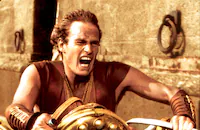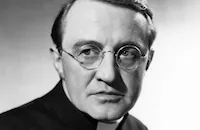The Pigeon That Took Rome
Brief Synopsis
Cast & Crew
Melville Shavelson
Charlton Heston
Elsa Martinelli
Harry Guardino
Baccaloni
Marietto
Film Details
Technical Specs

Synopsis
After the fall of Mussolini in 1944 Capt. Paul MacDougall and his radioman, Sgt. Joseph Contini, are smuggled into Nazi-occupied Rome to investigate enemy activities, though neither has had any training in espionage. They are met on the beach by Livio Massimo, an 11-year-old resistance fighter, who leads them to his father, Ciccio, leader of the Italian resistance. Massimo's daughter, Antonella, who is friendly with German officers, resents the intrusion of the American spies because the family is hungry, but she changes her mind when she learns that her sister, Rosalba, is pregnant and in need of a husband. Contini and Rosalba fall in love, and Massimo plans to announce their engagement at a feast, providing he can find enough food. Antonella innocently serves all but one of the carrier pigeons used by MacDougall to carry messages. Livio, trying to be helpful, replaces them with stolen German pigeons, which fly MacDougall's messages directly to the Nazis. Frantic, MacDougall sends insane, contradictory reports, but the surviving American pigeon carries one of these to the Americans at Anzio. The Americans decide to attack; Rome is liberated; Rosalba is married just as her baby arrives; MacDougall marries Antonella on the spur of the moment; and the lone American pigeon receives the Medal of Honor.

Director

Melville Shavelson
Cast

Charlton Heston

Elsa Martinelli

Harry Guardino

Baccaloni
Marietto
Gabriella Pallotta
Debbie Price

Brian Donlevy
Bob Gandett

Arthur Shields
Rudolph Anders
Gary Collins
Vadim Wolkonsky
Richard Nelson
Crew
Roland Anderson
Frank Bracht
Argentina Brunetti
Alessandro Cicognini
Sam Comer
Mario Del Papa
Andrew J. Durkus
Farciot Edouart
Daniel L. Fapp
John P. Fulton
Hugo Grenzbach
Jack Hayes
Hal C. Kern
Nellie Manley
Daniel J. Mccauley
Frank R. Mckelvy
Hal Pereira
Melville Shavelson
Melville Shavelson
Melville Shavelson
Leo Shuken
Irvin Talbot
Mae Wale-wright
Wally Westmore
Harriet White
John Wilkinson

Film Details
Technical Specs

Award Nominations
Best Art Direction
Articles
The Pigeon That took Rome - The Pigeon That Took Rome
After a string of serious roles in heavy-hitting films like The Ten Commandments (1956), Ben-Hur (1959) and El Cid (1961), Charlton Heston was eager to switch gears and find a lighter film in which to star. According to director Melville Shavelson, Herman Citron, Heston's agent at the time, agreed. "Herman was convinced Heston now needed another comedy," said Shavelson in his 2007 memoir How to Succeed in Hollywood Without Really Trying (P.S. You Can't!), "or he'd be playing Biblical roles for the rest of his career."
Meanwhile, Shavelson (Houseboat [1958]) was also looking for his next project to direct, and he found it in the form of Donald Downes' 1960 comic novel The Easter Dinner. "It was not only funny," said Shavelson, "it was based on reality, and had the sting of truth. And it was truly touching. And equally important, it was set in my favorite city (Rome), where I planned to have Paramount pick up my hotel bill."
Shavelson was surprised when he heard that Charlton Heston was interested in the role of MacDougall in The Easter Dinner. He originally had Bob Hope in mind for the part, but he was receptive to the idea of Heston. A meeting was arranged at Heston's house for the two to meet for the first time and talk about the project. Shavelson liked Heston immediately. "Although we are poles apart politically - I think Heston had his own pole--," said Shavelson, "he turned out to be completely affable, intelligent, and the possessor of a considerable sense of humor." The feeling from Heston was mutual, and the two agreed to make the film together.
One thing that everyone agreed on right away was that the title The Easter Dinner would have to be changed. "Any film called The Easter Dinner that starred Charlton Heston," said Shavelson, "would lead an audience to believe the opening scene would be the Last Supper, followed by the Crucifixion and the Resurrection. We didn't have the budget." Heston thought the film should be called Americans, Go Home!, but ultimately it was re-titled The Pigeon That Took Rome.
The location shoot in Italy went very well. Shavelson called the experience "pure joy", and Charlton Heston found Shavelson to be an effective director "with a sure instinct for comedy." Creatively, Shavelson challenged himself. He made the decision to shoot the film in black and white so that he could easily blend the footage he shot with real newsreel footage to give The Pigeon That Took Rome an authentic feeling of its wartime setting.
One major problem that Shavelson did run into while shooting in Rome was the Vatican's refusal to allow him to film an important scene among the famous Bernini Columns in front of St. Peter's Cathedral. "The Pope had been upset because he had given Federico Fellini his consent to shoot a scene for La Dolce Vita [1960] in the Vatican;" explained Shavelson in his memoir, "and Fellini had promptly flown a statue of Jesus Christ by helicopter over the sacred dome of St. Peter's, an aerial sacrilege." Shavelson tried to explain to the Italian officials that he would not pull any such stunt, but they refused to budge. He considered re-creating the location on the Paramount lot, but it would be too expensive. His Italian production manager soon came up with a better idea. "He told me his brother worked in the Vatican," said Shavelson, "and informed him the Bishop in charge of illegal filmmakers never arose before 10:00 a.m. If we could get our shot by that time, and get our equipment out, the Bishop would be checkmated."
The cast and crew assembled at 6:00 a.m. at the Bernini Columns and shot as much as they could of the scene before the Bishop was due to awaken. "All went well until about 8:30," said Shavelson, "when the Bishop had to answer the call of nature and happened to stare out of his window. Sacrilege! Disobedience of a Papal order! Vatican police...started to descend on our company...there was a long, convoluted argument in Italian as our production manager and his brother held the police off until we completed the shot. Then the actors and the equipment were tossed into our trucks and the invasion of the Vatican was concluded. If I had been Fellini, I would have had a few helicopters standing by for the evacuation."
When filming was complete, a strike in Hollywood by the below-the-line unions forced Shavelson to go to New York to complete post-production on The Pigeon That Took Rome. Just as the completed film was ready to be previewed, however, disaster struck. The negative of the entire first reel disappeared and was nowhere to be found. Shavelson did what he could to salvage the first reel by re-assembling the old newsreel footage and using the second generation dailies that he still had. The resulting new first reel had a "fuzzy" look to it that actually got praised for giving the film verisimilitude. The missing original reel turned up many years later in the original New York film lab stuck behind a ventilator. According to Shavelson, it had been placed there by a "Union member in sympathy with his striking brethren in Hollywood" at the time. "If I knew his name," said Shavelson, "I would thank him."
The Pigeon That Took Rome opened in the summer of 1962 to mostly positive reviews. "Shavelson has gotten into the 101 minutes of running time some good, imaginative humor," said Variety. "He has his picture rolling without pause and endowed it with witty dialog and script situations. The performances are savvy, the editing sharp and the music, used to bridge one scene to another, correctly functional." Time magazine said, "The Pigeon That Took Rome lays a heap of small eggs that scramble surprisingly well."
The international cast also features Elsa Martinelli as Charlton Heston's love interest and scene stealing opera star Salvatore Baccaloni in his last feature film role as Martinelli's father. The film received an Academy Award nomination for Best Art Direction.
Producer: Melville Shavelson
Director: Melville Shavelson
Screenplay: Melville Shavelson; Donald Downes (novel "The Easter Dinner")
Cinematography: Daniel L. Fapp
Art Direction: Roland Anderson, Hal Pereira
Music: Alessandro Cicognini
Film Editing: Frank Bracht
Cast: Charlton Heston (Captain Paul MacDougall/Benny the Snatch/Narrator), Elsa Martinelli (Antonella Massimo), Harry Guardino (Sgt. Joseph Contini), Salvatore Baccaloni (Ciccio Massimo), Marietto (Livio Massimo), Gabriella Pallotta (Rosalba Massimo), Brian Donlevy (Col. Sherman Harrington), Arthur Shields (Monsignor O'Toole), Rudolph Anders (Col. Wilhelm Krafft), Vadim Wolkowsky (Conte Danesi).
BW-102m. Letterboxed.
by Andrea Passafiume

The Pigeon That took Rome - The Pigeon That Took Rome
Quotes
Trivia
Notes
Location scenes filmed in Rome. The working title of this film is The Easter Dinner.

Miscellaneous Notes
Released in United States 1962
Released in United States 1962













